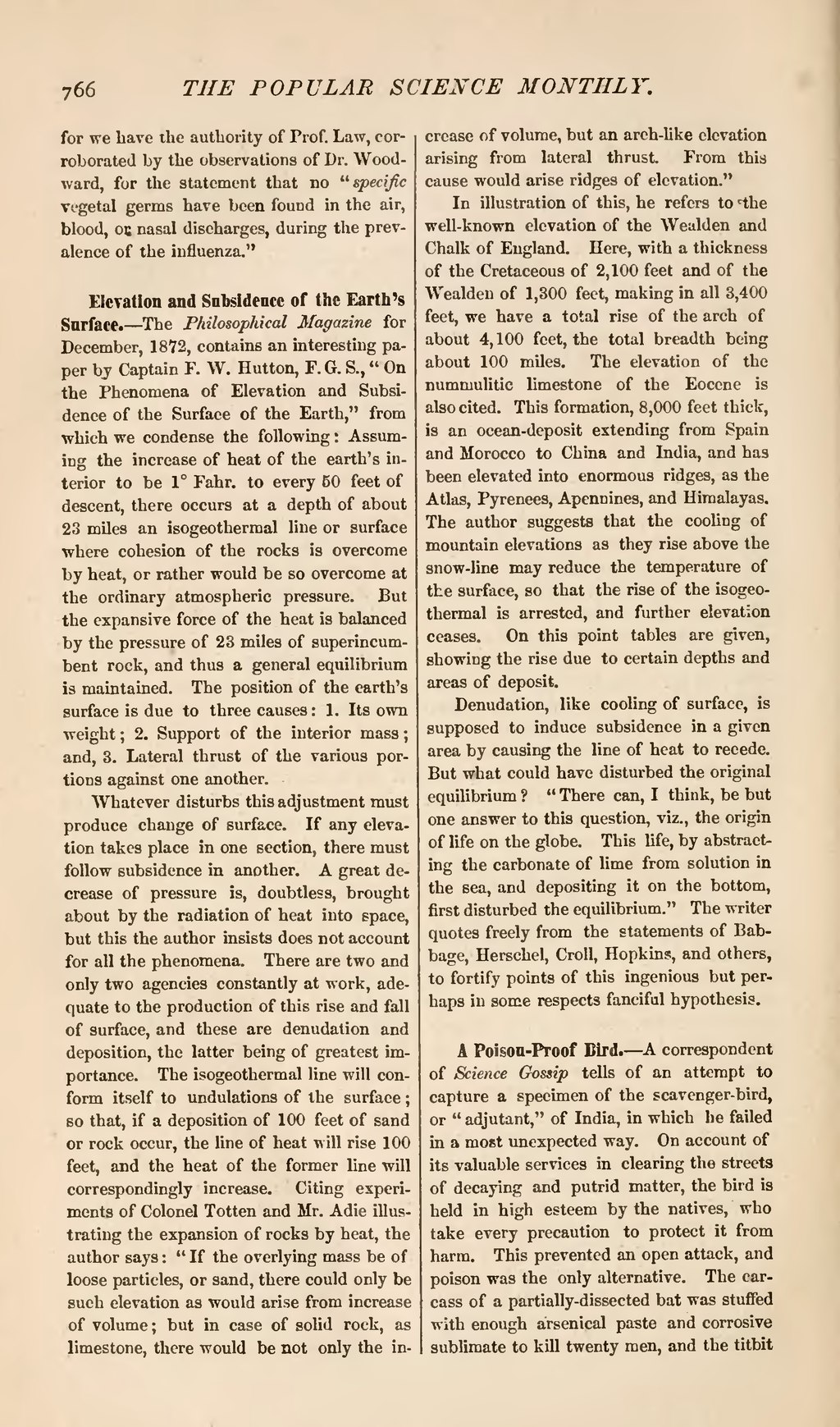for we have the authority of Prof. Law, corroborated by the observations of Dr. Woodward, for the statement that no "specific vegetal germs have been found in the air, blood, 05 nasal discharges, during the prevalence of the influenza."
Elevation and Subsidence of the Earth's Surface.—The Philosophical Magazine for December, 1872, contains an interesting paper by Captain F. W. Hutton, F.G.S., "On the Phenomena of Elevation and Subsidence of the Surface of the Earth," from which we condense the following: Assuming the increase of heat of the earth's interior to be 1° Fahr. to every 50 feet of descent, there occurs at a depth of about 23 miles an isogeothermal line or surface where cohesion of the rocks is overcome by heat, or rather would be so overcome at the ordinary atmospheric pressure. But the expansive force of the heat is balanced by the pressure of 23 miles of superincumbent rock, and thus a general equilibrium is maintained. The position of the earth's surface is due to three causes: 1. Its own weight; 2. Support of the interior mass; and, 3. Lateral thrust of the various portions against one another.
Whatever disturbs this adjustment must produce change of surface. If any elevation takes place in one section, there must follow subsidence in another. A great decrease of pressure is, doubtless, brought about by the radiation of heat into space, but this the author insists does not account for all the phenomena. There are two and only two agencies constantly at work, adequate to the production of this rise and fall of surface, and these are denudation and deposition, the latter being of greatest importance. The isogeothermal line will conform itself to undulations of the surface; so that, if a deposition of 100 feet of sand or rock occur, the line of heat will rise 100 feet, and the heat of the former line will correspondingly increase. Citing experiments of Colonel Totten and Mr. Adie illustrating the expansion of rocks by heat, the author says: "If the overlying mass be of loose particles, or sand, there could only be such elevation as would arise from increase of volume; but in case of solid rock, as limestone, there would be not only the increase of volume, but an arch-like elevation arising from lateral thrust. From this cause would arise ridges of elevation."
In illustration of this, he refers to the well-known elevation of the Wealden and Chalk of England. Here, with a thickness of the Cretaceous of 2,100 feet and of the Wealden of 1,300 feet, making in all 3,400 feet, we have a total rise of the arch of about 4,100 feet, the total breadth being about 100 miles. The elevation of the nummulitic limestone of the Eocene is also cited. This formation, 8,000 feet thick, is an ocean-deposit extending from Spain and Morocco to China and India, and has been elevated into enormous ridges, as the Atlas, Pyrenees, Apennines, and Himalayas. The author suggests that the cooling of mountain elevations as they rise above the snow-line may reduce the temperature of the surface, so that the rise of the isogeothermal is arrested, and further elevation ceases. On this point tables are given, showing the rise due to certain depths and areas of deposit.
Denudation, like cooling of surface, is supposed to induce subsidence in a given area by causing the line of heat to recede. But what could have disturbed the original equilibrium? "There can, I think, be but one answer to this question, viz., the origin of life on the globe. This life, by abstracting the carbonate of lime from solution in the sea, and depositing it on the bottom, first disturbed the equilibrium." The writer quotes freely from the statements of Babbage, Herschel, Croll, Hopkins, and others, to fortify points of this ingenious but perhaps in some respects fanciful hypothesis.
A Poison-Proof Bird.—A correspondent of Science Gossip tells of an attempt to capture a specimen of the scavenger-bird, or "adjutant," of India, in which he failed in a most unexpected way. On account of its valuable services in clearing the streets of decaying and putrid matter, the bird is held in high esteem by the natives, who take every precaution to protect it from harm. This prevented an open attack, and poison was the only alternative. The carcass of a partially-dissected bat was stuffed with enough arsenical paste and corrosive sublimate to kill twenty men, and the titbit
